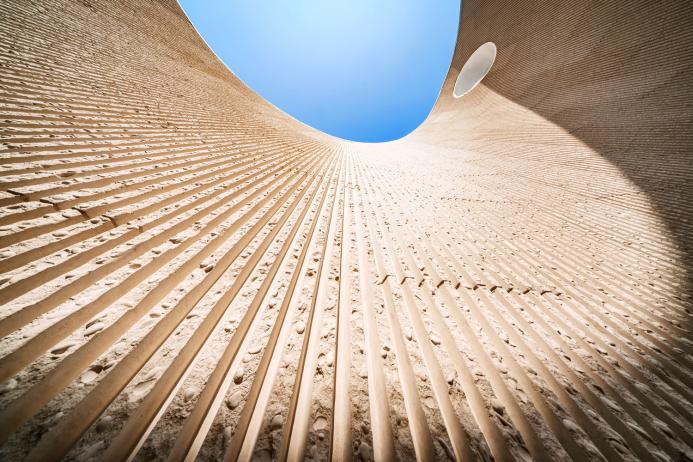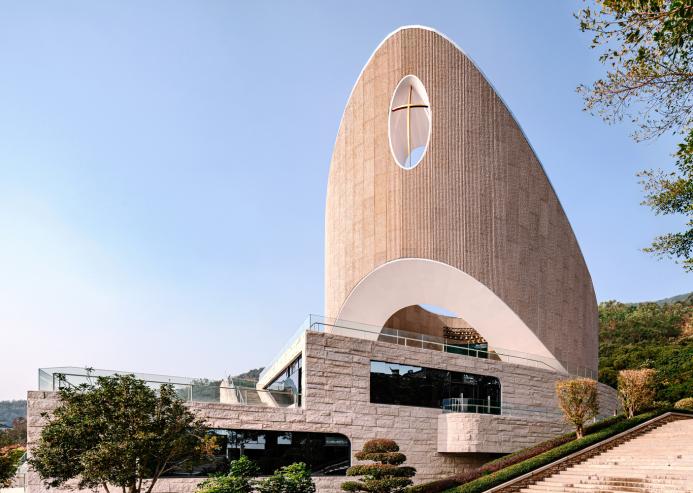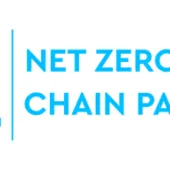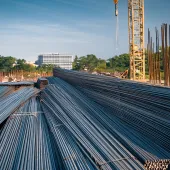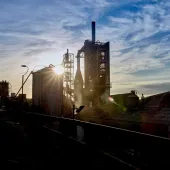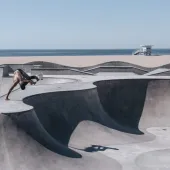GRC chosen for Mountain Church of Julong
Situated at the foot of a mountain, the church evokes the form of a biblical ark resting on a rock, symbolising shelter and new beginnings.
Inuce founder Dirk U Moench explains that the ark motif was fundamental in the design process. "As a powerful symbol for shelter and new beginnings, the ark of salvation, safely landed on a foundation of rock, became the crystallisation point for our design," he says. "The idea underlies all the essential architectural choices with regards to the church's nave, defining its iconic form, colour palette, and, of course, its placement at the highest point of the site."
The main hall of the church, which can host 1,000 worshipers, is placed at the top of the site and designed to look like an abstracted ark. Its oval shape is clad in scored GRC panels that also wrap around the circular entrance atrium. These panels are central to the church's aesthetic, providing durability while offering a textured, nuanced appearance that complements the overall design. "The GRC panels allowed us to achieve the desired form and texture, giving the church a modern yet timeless look," Moench notes.
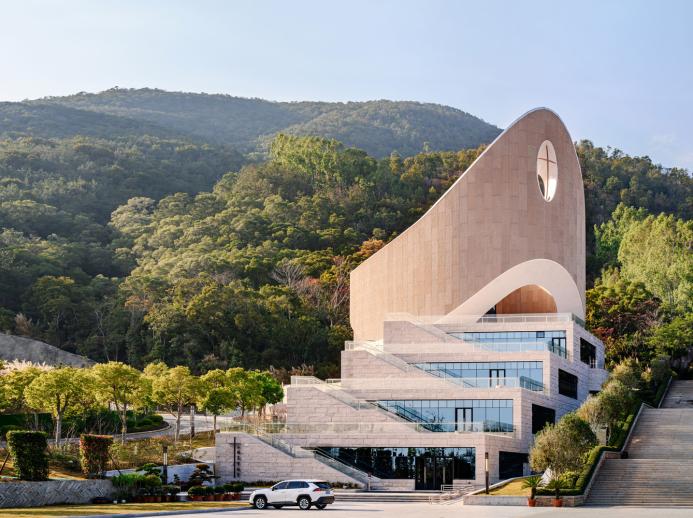
The church's design features four terraces clad in granite slabs, stepping up the hill to resemble a rocky outcrop. At the front, the building is raised to provide access to the entrance atrium and is topped with a public viewpoint. "We aimed for an experience that would touch both body and soul," says Moench. "We added an extra layer to the ark's bow, creating a contemplative atrium inspired by medieval tradition, which visitors pass through before entering the sanctuary. Shaping this, we imagined the stern of the ark rising, revealing a vast space flooded by nature, a striking echo of Christ's sermon on the mount."
The Mountain Church of Julong is the first permanent church for a congregation that previously met in a rented shop. In addition to serving as a place of worship, the church includes a small library, study rooms, and conference facilities, making it a community hub.
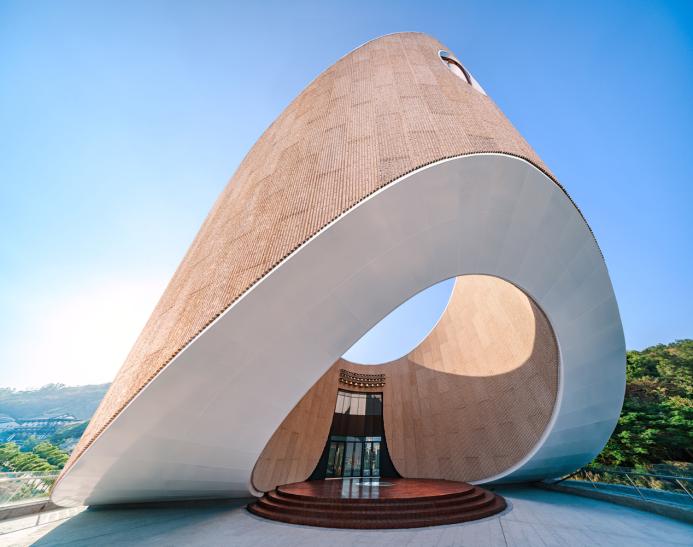
Moench believes the church will become a cornerstone of Julong, fostering social cohesion as a space for people of all beliefs to gather, learn, and grow together. This project is the latest in a series of distinctive churches designed by Inuce in China, breaking away from traditional forms and aiming to integrate into the city's social fabric. "The Mountain Church breaks the mould, offering a glimpse into what Chinese churches are poised to become: vibrant hubs essential to the city's social and spatial fabric," he concludes.
"Given the location at the foot of a mountain peak, the project had every chance to become a religious landmark," Moench explains. "But being the first church in a newly developed city, it needed to be more than just a place of worship. Making sure the design is inclusive, conveying a message of belonging addressed at the entire community, was at the heart of the congregation's mission. Moving forward, we envision the church becoming a cornerstone of Julong, fostering social cohesion as a space where people of all beliefs can gather, learn, and grow together."

Glass-reinforced concrete
Glass-reinforced concrete (GRC), also known as glass-fiber reinforced concrete (GFRC), is a type of fiber-reinforced concrete that uses glass fibers to enhance its structural properties. GRC panels are widely used in modern construction due to their versatility, durability, and aesthetic qualities.
Made from a mix of fine sand, cement, polymer (usually acrylic), water, and alkali-resistant (AR) glass fibers, GRC is typically sprayed or cast into molds to create panels of various shapes and sizes. The glass fibers within the mix provide tensile strength and flexibility.
The inclusion of glass fibers significantly enhances the tensile strength of the concrete, making it less prone to cracking. GRC panels are resistant to weathering, chemicals, and fire, making them suitable for both interior and exterior applications.
Compared to traditional concrete, GRC panels are much lighter due to the reduced thickness required to achieve comparable strength. This makes them easier to handle and install.
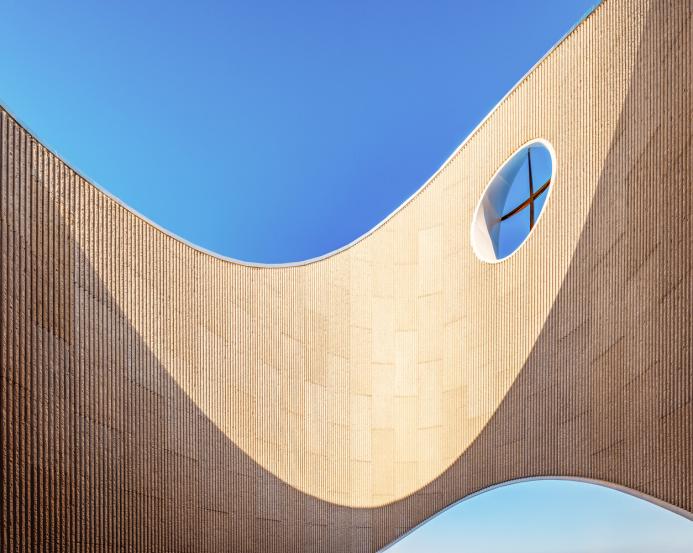
GRC can be molded into intricate shapes, allowing for a wide range of design possibilities. This is particularly useful for architectural elements that require custom or complex forms. GRC panels can also be finished in various textures and colors, offering aesthetic versatility to match different architectural styles.
GRC panels typically use less raw material compared to traditional concrete elements, contributing to resource efficiency. Lighter panels reduce transportation energy and costs, and their durability minimizes the need for replacements.
GRC panels are commonly used for cladding buildings, providing an attractive and durable exterior finish.
In the design of the Mountain Church of Julong, GRC panels play a central role. The church’s main hall, designed to look like an abstracted ark, is clad in scored GRC panels. These panels provide a textured, nuanced appearance that enhances the building's aesthetic while ensuring durability and structural integrity. The use of GRC panels allows for the creation of the church's complex forms and smooth finishes, contributing to its iconic look and feel.
